Sometimes we paleontologists, especially those who also study modern organisms and their behaviors, get a little too sure of ourselves, thinking we have a clear vision of life during the pre-human past. So it’s good to have that confidence shaken a little, made uneasy by a glimpse at a much deeper past, one that preceded the bulk of fossils that shape our accepted norms and basic expectations in paleontology.
Welcome to the Ediacaran Period, the span of earth history from 635-542 million years ago, and a time when actualism – the precept that the present is the key to the past – becomes a naïve, idealistic dream, a glib summary of a world that has only existed for a mere 12% of earth history.
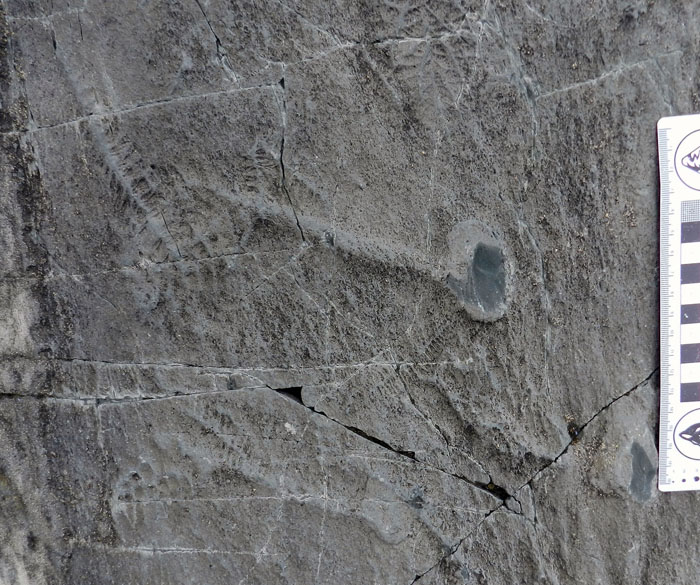 What are these? They’re fossils, but otherwise I’m not sure what else to tell you: guess I’ve been spending too much time in the present. But for for those people who have studied them and know better than me, they’re called Charniodiscus, and they’re frond-like fossils with holdfasts (those circular parts connected to their stems) that kept them attached to the seafloor about 565 million years ago. All you have to do to see these fossils is go to Newfoundland, Mistaken Point Ecological Reserve in Newfoundland, Canada, get permission from the Reserve to visit them, have a guide accompany you, and walk 40-45 minutes to the site from a car park. Incidentally, there will be absolutely no cafes or toilets on the way there. You know, just like how it was in the Precambrian. (Photograph by Anthony Martin; scale in centimeters.)
What are these? They’re fossils, but otherwise I’m not sure what else to tell you: guess I’ve been spending too much time in the present. But for for those people who have studied them and know better than me, they’re called Charniodiscus, and they’re frond-like fossils with holdfasts (those circular parts connected to their stems) that kept them attached to the seafloor about 565 million years ago. All you have to do to see these fossils is go to Newfoundland, Mistaken Point Ecological Reserve in Newfoundland, Canada, get permission from the Reserve to visit them, have a guide accompany you, and walk 40-45 minutes to the site from a car park. Incidentally, there will be absolutely no cafes or toilets on the way there. You know, just like how it was in the Precambrian. (Photograph by Anthony Martin; scale in centimeters.)
These discomforting realizations started a little less than two weeks ago, inspired by a field trip to the Ediacaran-Cambrian rocks of eastern Newfoundland, Canada. Why was I in cool, temperate Newfoundland, instead of sweating it out on the summertime Georgia coast? The occasion was a pre-meeting trip associated with the International Congress on Ichnology, simply known among ichnologists as Ichnia. This was the third such meeting, a once-every-four-years event (coinciding with years of the summer Olympics). The previous two were in Krakow, Poland (2008) and Trelew, Argentina (2004), and thus far these meetings also include fabulous field trips.
For Ichnia 2012, upon seeing an announcement of a field trip to Mistaken Point and other localities associated with the Precambrian-Cambrian boundary, I eagerly signed up for it. You see, Mistaken Point is world famous for its extraordinary preservation of more than 1,000 body fossils of those weird and wonderful fossils known as the Ediacaran fauna, Ediacaran biota, Vendian fauna, or Vendobionts (take your pick). This was the main reason why my fellow ichnologists on the field trip – 16 of us from 9 countries – were along for the ride, despite the trip’s clear emphasis on body fossils.
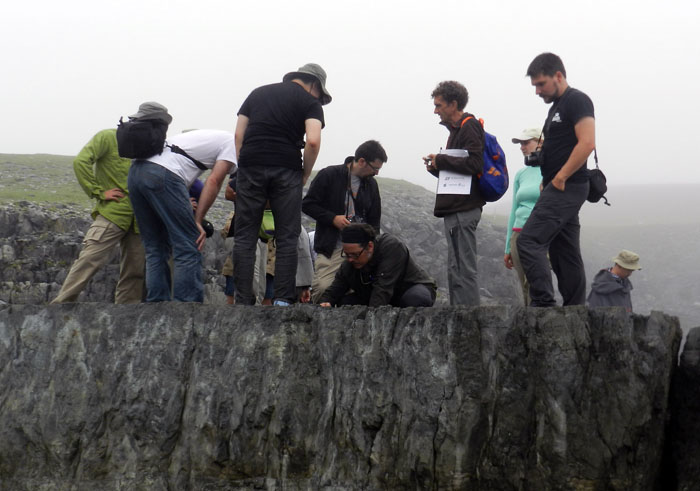 A rare photo of ichnologists getting really excited about seeing body fossils, which is totally understandable when we’re talking about the Ediacaran fossils at Mistaken Point, Newfoundland. Eventually, though, they later became unruly and started demanding, “Show me your trace fossils!” Fortunately for the sake of international ichnological relations, the field-trip leaders happily obliged that same day. (Photograph by Ruth Schowalter.)
A rare photo of ichnologists getting really excited about seeing body fossils, which is totally understandable when we’re talking about the Ediacaran fossils at Mistaken Point, Newfoundland. Eventually, though, they later became unruly and started demanding, “Show me your trace fossils!” Fortunately for the sake of international ichnological relations, the field-trip leaders happily obliged that same day. (Photograph by Ruth Schowalter.)
These rare fossils, which are strange enough to even cause paleontologists to question whether or not they are animals (hence the cautious use of the more inclusive term “biota” instead of “fauna”), are abundantly exposed on broad bedding planes in Mistaken Point Ecological Reserve on the southeastern coast of Newfoundland. Discovered in 1967, these fossils have since proved to be one of the best examples of easily visible body fossils from more than 542 million years ago, and the Newfoundland fossils comprise the only such assemblage that originally lived in deep-marine environments. They evidently died in place when suffocated by a layer of volcanic ash that settled onto the seafloor, hence the fossils reflect a probable sample of their original ecosystem. This ash layer neatly preserved the fossils, and its minerals provided a means to calculate absolute age dates for the assemblage, which is from 565 +/- 3 mya (million years ago).
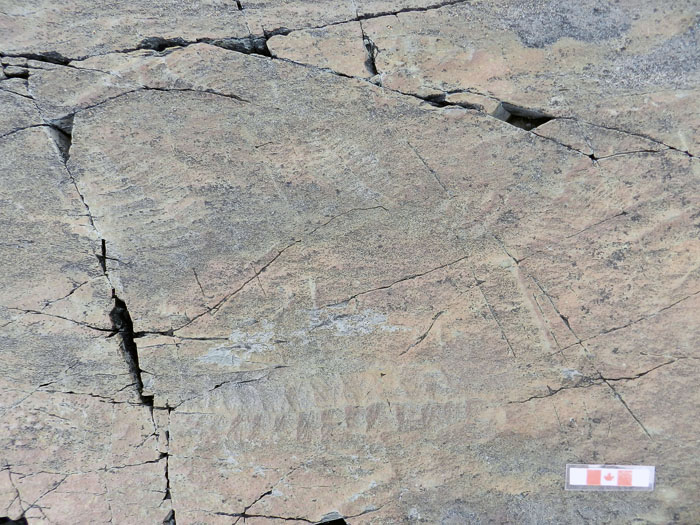 Bedding-plane exposure at Mistaken Point with many frond-like fossils, broadly referred to as rangeomorphs. (Photograph by Anthony Martin, Canadian-themed scale is in centimeters.)
Bedding-plane exposure at Mistaken Point with many frond-like fossils, broadly referred to as rangeomorphs. (Photograph by Anthony Martin, Canadian-themed scale is in centimeters.)
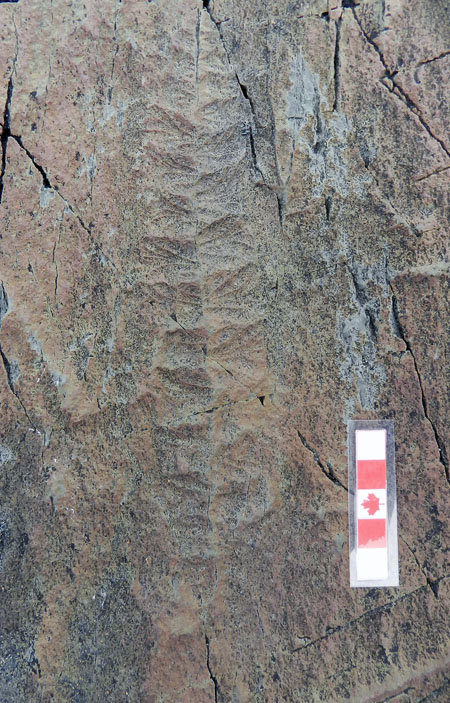 A close-up of one of the more exquisitely preserved rangeomorphs, which I think is Fractofusus misrai. But you really shouldn’t trust this ichnologist with that identification, so it’d be wise to double-check that with a real expert. (Photograph by Anthony Martin.)
A close-up of one of the more exquisitely preserved rangeomorphs, which I think is Fractofusus misrai. But you really shouldn’t trust this ichnologist with that identification, so it’d be wise to double-check that with a real expert. (Photograph by Anthony Martin.)
Just a few years ago, though, Mistaken Point became paleontologically famous again, and this time for its trace fossils. Researchers from Memorial University in Newfoundland and Oxford University looked at bedding planes near those holding the the body fossils, and were surprised to find a few trails there. At that time, it was the oldest evidence of animal movement from the fossil record, and although these finds have been disputed and others have tried to stake this claim for trace fossils elsewhere, it is still holding up fairly well.
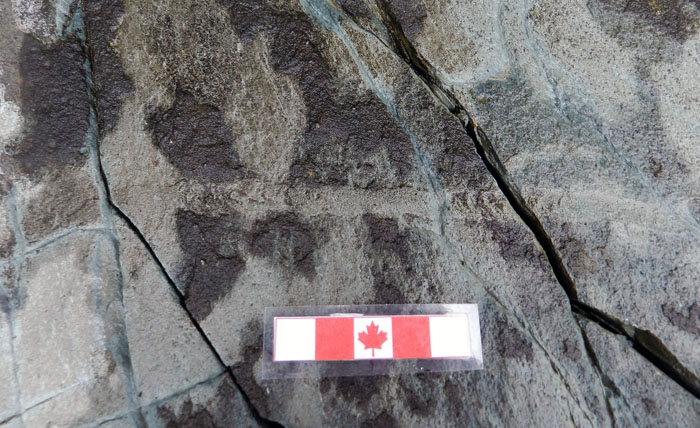 A surface trail, probably made by a < 1 cm wide animal moving along the seafloor about 565 mya. The animal moved from left to right, which is indicated by the crescentic ridges inside the trail, which open in the direction of movement. (Photograph by Anthony Martin, taken at Mistaken Point, Newfoundland.)
A surface trail, probably made by a < 1 cm wide animal moving along the seafloor about 565 mya. The animal moved from left to right, which is indicated by the crescentic ridges inside the trail, which open in the direction of movement. (Photograph by Anthony Martin, taken at Mistaken Point, Newfoundland.)
 Another surface trail, but this one without the internal structure of the other one, and with levees on either side of the central furrow. (Photograph by Anthony Martin, taken at Mistaken Point, Newfoundland.)
Another surface trail, but this one without the internal structure of the other one, and with levees on either side of the central furrow. (Photograph by Anthony Martin, taken at Mistaken Point, Newfoundland.)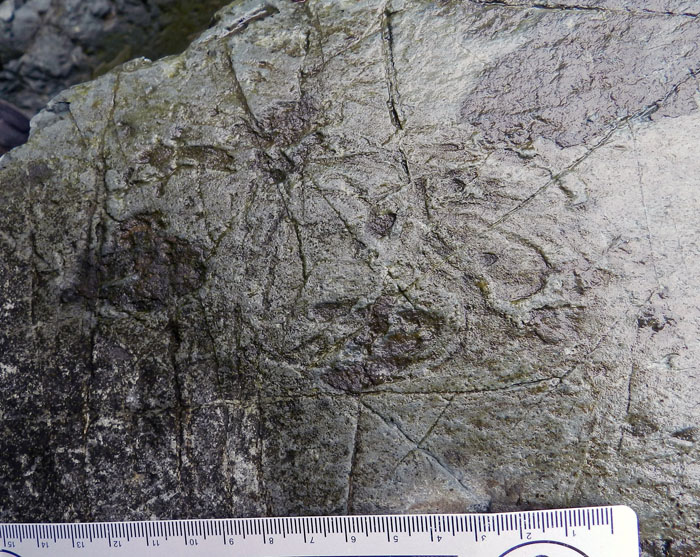 What’s this? Don’t have a clue. It looks like a series of overlapping trails, some looping, but would have taken me several hours to unravel. Anyway, it generated some good discussion at the outcrop, and they’re probably trace fossils, which made us ichnologists both happy and perplexed. (Photograph by Anthony Martin, taken at Mistaken Point, Newfoundland; scale in centimeters.)
What’s this? Don’t have a clue. It looks like a series of overlapping trails, some looping, but would have taken me several hours to unravel. Anyway, it generated some good discussion at the outcrop, and they’re probably trace fossils, which made us ichnologists both happy and perplexed. (Photograph by Anthony Martin, taken at Mistaken Point, Newfoundland; scale in centimeters.)
What made these trace fossils? It’s hard to say, and that’s a humbling statement for me to make. In public talks I’ve given about my upcoming book, and in a presentation I gave the following week at Ichnia on the Memorial University campus, I’ve assured how the actualism of the Georgia barrier islands and its traces can reliably serve as models for interpreting many trace fossils formed in different environments, and trace fossils of various geologic ages from around the world. But in this instance, I didn’t have a inkling of what made the Mistaken Point trace fossils. These trace fossils were also made in deep-marine environments, which are lacking from the Georgia coast, and I haven’t learned much about deep-marine trace fossils from elsewhere.
In short, my ignorance was showing, and these trace fossils were completely out of my realm of experience. The only feeble hypothesis I could conjure on the basis of what I’ve seen in modern sediments of the Georgia barrier islands are small marine gastropod trails. Sorry, that’s all I got.
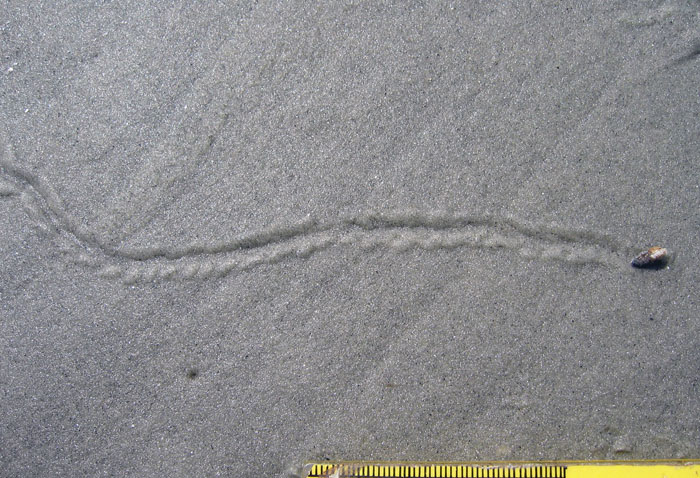 Oooo, look, it’s snail! Making a trail! Isn’t that neat? And if you squint really hard and have a couple of beers, you might agree that it almost resembles one of the fossil trails from Mistaken Point. Don’t see it yet? Here, have another beer. (Photograph by Anthony Martin, taken at Sapelo Island, Georgia; scale in millimeters. )
Oooo, look, it’s snail! Making a trail! Isn’t that neat? And if you squint really hard and have a couple of beers, you might agree that it almost resembles one of the fossil trails from Mistaken Point. Don’t see it yet? Here, have another beer. (Photograph by Anthony Martin, taken at Sapelo Island, Georgia; scale in millimeters. )
But if ignorance loves company, I can feel good in knowing that others have grasped at the same straw of actualism and found it far too short. I could tell a few of my ichnological colleagues were likewise a little challenged by what they saw at Mistaken Point, and I knew that for some of them – like me – they normally deal with trace fossils in much younger rocks. But hey, that’s what geology field trips are supposed to do: challenge us with what’s really there in the rock record, right there in front of us, rather than what we wish were there.
Fortunately, a little more information provided during the meeting after the field trip helped my understanding of the trace fossils we saw at Mistaken Point, and actually connected to modern tracemakers. Alexander Liu, the primary author of the paper that first reported the trace fossils, gave a talk that reviewed the evidence for Precambrian trace fossils, including those from Mistaken Point. In experiments he and his coauthors did with living anemones in a laboratory setting, they were able to reproduce trails similar to the Mistaken Point trace fossil with the internal structure. Thus these researchers were able to use actualism to assist in their interpretation, which also meant that neoichnology was not so useless after all when applied to the Ediacaran. That made me feel a little better.
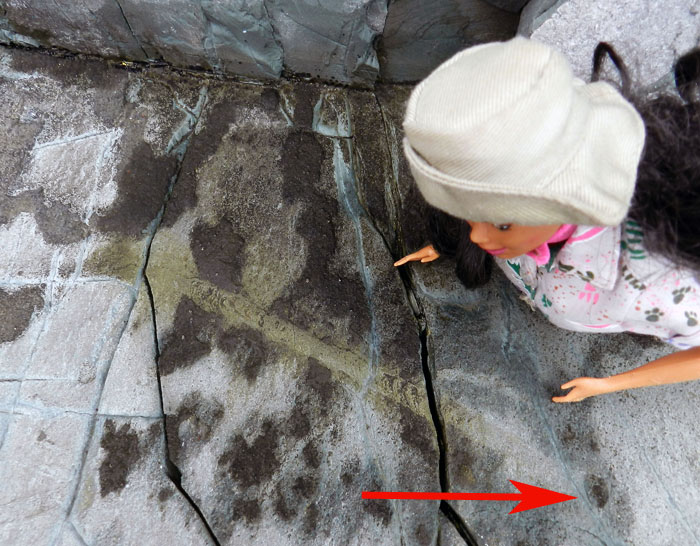 Let’s take a look at that first surface trail again, but this time with the help of my trustworthy colleague Paleontologist Barbie, who was along for the field trip. The crecentic ridges in the interior of the trail may represent marks where the basal disc of a anemone-like animal pushed against the surface as it moved. Even more interesting, the arrow points to an oval impression, which may be a resting trace that shows the approximate basal diameter of the tracemaker. What was the tracemaker? It’s currently identified as a small anemone, which is based on modern traces. Neoichnology rules! (Photograph by Anthony Martin.)
Let’s take a look at that first surface trail again, but this time with the help of my trustworthy colleague Paleontologist Barbie, who was along for the field trip. The crecentic ridges in the interior of the trail may represent marks where the basal disc of a anemone-like animal pushed against the surface as it moved. Even more interesting, the arrow points to an oval impression, which may be a resting trace that shows the approximate basal diameter of the tracemaker. What was the tracemaker? It’s currently identified as a small anemone, which is based on modern traces. Neoichnology rules! (Photograph by Anthony Martin.)
Ediacaran trace fossils still engender debate, though, and especially with people who don’t necessarily accept that animals made trails during the Ediacaran. For instance, about four years ago, some scuba-diving researchers observed a giant protozoan making a trail on a sediment surface in the Bahamas. Accordingly, they proposed that one-celled organisms – not animals – could have made similar trails during the Ediacaran Period. Interestingly, this shows how actualism can produce conflicting results when applied to Ediacaran fossils. After all, it’s still a big world out there, and we humans haven’t really observed everything in it yet.
So I’ll make one last point about Ediacaran fossils here, then will move on to more recent times. If you think that at the very least we paleontologists should be able to tell the difference between trace fossils and body fossils in Ediacaran rocks, you’re also in for some confusion. In the only research article I have ever attempted on Ediacaran fossils, which were much closer to Georgia – coming from the Carolina Slate Belt of North Carolina – my coauthors and I struggled with exactly that question with some fossils found in that area. In the end, we said they were body fossils, not trace fossils. And as everyone knows, I love trace fossils, and I really wanted these to be trace fossils. But they were not. That’s science for you: denying your deepest desires in the face of reality.
So surely the Cambrian would be easier to interpret, right? I meanl, after 542 mya, animals started burrowing merrily, to and fro, hither and tither, with uninhibited and orgiastic abandon, and, well, you get the idea. But, not really. Another part of the field trip involved looking at what happened with the departure of the relatively unbioturbated alien world of the Ediacaran, pre-542 mya, to the more familiar sediment mixing of the Cambrian and Ordovician Periods, post-542 mya. Yet even these rocks and their trace fossils were still not quite like what we see today.
This will be the subject of my next post, which will again explore the theme of how we should approach strict actualism like any scientifically based idea: with a mixture of astonished wonder, but also with a hard-edged look at what is really there.
As we bid adieu to Mistaken Point and began our walk back to the car park, we could swear we saw lifeforms emerging from the mist-covered rocks, resurrected from the deep time and deep water of the Avalonian Precambrian. Then we realized those were just some of our group behind us. Oh well. Maybe next time. (Photograph by Anthony Martin.)
(Acknowledgements: Much appreciation is extended to the field trip leaders – Liam Herringshaw, Jack Matthews, and Duncan McIlroy – for their organization and execution of a fantastic three-day field trip; to Valerie and Richard of the Mistaken Point Ecological Reserve for guiding us to the site; to my ichnological colleagues for their cheery and knowledge-broadening company; and my wife Ruth for being with me and providing an artist’s perspective about her experiences with us crazy ichnologists, shared here and here.)
Further Reading
Fedonkin, M., Vickers-Rich, P. Grey, K., and Narbonne, G. 2007.The Rise of Animals: Evolution and Diversification of the Animalia. Johns Hopkins Press, Washington: 320 p.
Liu, A.G., McIlroy, D., and Brasier, M.D. 2010. First evidence for locomotion in the Ediacaran biota from the 565Ma Mistaken Point Formation, Newfoundland. Geology, 38: 123-126.
Matz, M.V., Frank. T.M., Marshall, N.J., Widder, E.A., and Johnsen, S. 2008. Giant deep-sea protest produces bilaterian-like traces. Current Biology, 18: 1-6
Tacker, R.C., Martin, A.J., Weaver, P.G., and Lawver, D.R. 2010. Trace vs. body fossil: Oldhamia recta revisited. Precambrian Research, 178: 43-50.
Vickers-Rich, P., and Komarower, P. (editors). 2007 The Rise and Fall of the Ediacaran Biota. Geological Society of London, Special Publication 286: 448 p.

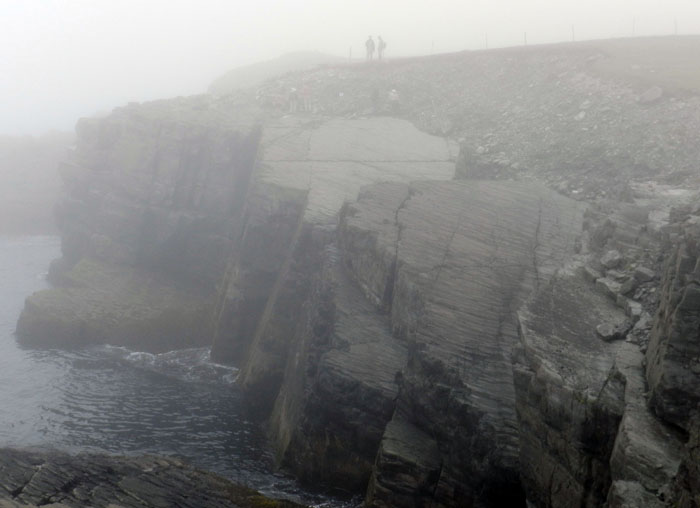
Pingback: ‘Captain Picard, our sensors are reading strange life-forms on the surface of Terranova’ « infaunal epiphany